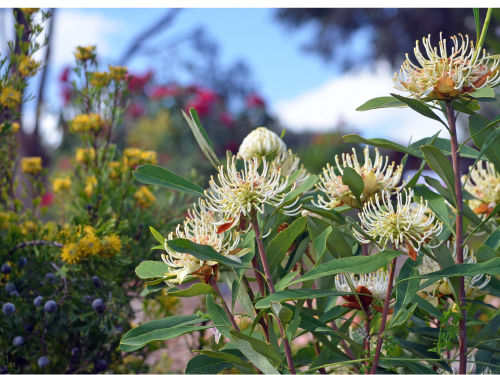Drought-Tolerant Plants: Best Choices for CA Landscapes
New Title

In California, where water conservation is critical, selecting drought-tolerant plants for commercial landscaping maintenance is essential. These plants reduce water usage and enhance the aesthetic appeal and sustainability of landscapes. This article explores the top choices for drought-tolerant plants suitable for commercial properties in Vista, San Marcos, and Carlsbad, CA.
Understanding Drought-Tolerant Plants:
Drought-tolerant plants possess adaptations that enable them to thrive in arid conditions. These adaptations may include succulence, deep root systems, or waxy coatings to minimise water loss through transpiration. Understanding these characteristics can help businesses make informed decisions when selecting plants for their commercial landscapes.
Importance of Drought-Tolerant Plants in Commercial Landscaping Maintenance:
In regions like Vista, San Marcos, and Carlsbad, where water resources are limited, incorporating drought-tolerant plants into commercial landscapes is crucial. These plants require less irrigation, reducing water consumption and lowering business maintenance costs. Additionally, by choosing drought-tolerant species, commercial properties can contribute to water conservation efforts and promote environmental sustainability.
Factors Influencing Plant Selection:
a. Climate and Location: The specific climate and microclimates of Vista, San Marcos, and Carlsbad influence plant selection. Businesses should choose plants that can thrive in the region's temperature fluctuations, sunlight exposure, and soil conditions.
b. Water Requirements: Selecting plants with low water requirements is essential for conserving water and minimising irrigation needs. Businesses can choose from various drought-tolerant species that have adapted to survive with minimal moisture.
c. Aesthetic Considerations: While prioritising drought tolerance, businesses should also consider the visual appeal of the plants. Combining colours, textures, and heights can create visually stunning landscapes that attract customers and enhance curb appeal.
d. Maintenance Needs: Low-maintenance plants reduce the time and resources required for commercial landscaping maintenance. Drought-tolerant plants typically require less pruning, fertilisation, and pest control, resulting in business cost savings.
Top Drought-Tolerant Plant Choices:
a. Succulents:
Succulents like Agave, Aloe, and Echeveria are popular choices for commercial landscapes due to their water-storing capabilities and striking appearance.
b. California Natives:
Native plants such as California Poppy, Manzanita, and Toyon are well-adapted to the local climate and require minimal watering once established.
c. Mediterranean Plants:
Species like Lavender, Rosemary, and Bougainvillea thrive in dry, sunny conditions, making them ideal for California landscapes.
d. Ornamental Grasses:
Ornamental grasses such as Blue Fescue, Mexican Feather Grass, and Fountain Grass add texture and movement to landscapes while requiring little water.
Designing with Drought-Tolerant Plants:
Integrating drought-tolerant plants into commercial landscapes requires careful planning and design. Grouping plants with similar water needs, incorporating mulch to retain moisture, and selecting appropriate irrigation systems can help businesses create sustainable and visually appealing landscapes.
Maintenance Tips for Drought-Tolerant Landscapes:
Once established, drought-tolerant landscapes require minimal maintenance. However, periodic watering during dry spells, pruning to remove dead or damaged growth, and monitoring for pests and diseases are essential to ensure plant health and vitality.
Case Studies: Showcase successful examples of commercial properties in Vista, San Marcos, and Carlsbad that have implemented drought-tolerant landscapes. Highlight the benefits experienced, such as reduced water bills, improved aesthetics, and positive community feedback.
Conclusion:
In conclusion, selecting drought-tolerant plants for commercial landscaping maintenance in Vista, San Marcos, and Carlsbad, CA, offers numerous benefits, including water conservation, cost savings, and environmental sustainability. By carefully considering climate, water requirements, and aesthetic preferences, businesses can create beautiful, resilient landscapes that thrive despite California's water challenges.
How Can Coast Landscaping Help You with Landscaping Maintenance Service?
Coast Landscaping offers professional commercial landscaping maintenance services in Vista, San Marcos, and Carlsbad, CA. With our expertise in drought-tolerant plant selection, landscape design, and maintenance, we can help you create and maintain beautiful, sustainable landscapes that enhance your commercial property's curb appeal and environmental responsibility. Contact us today to learn more about our services and how we can assist you with your landscaping needs.
FAQs:
What are the main benefits of using drought-tolerant plants in commercial landscaping?
Using drought-tolerant plants in commercial landscaping offers several key benefits:
- Water Conservation: Drought-tolerant plants require minimal watering compared to traditional landscaping, reducing water usage and promoting sustainability, especially in regions prone to drought or water restrictions.
- Cost Savings: By reducing water consumption, drought-tolerant landscaping can lead to significant cost savings on water bills for commercial properties, making it a financially prudent choice in the long run.
- Low Maintenance: Drought-tolerant plants are typically hardy and require less maintenance, such as pruning, fertilizing, and pest control, saving time and labor costs for property owners and maintenance crews.
- Resilience: Drought-tolerant plants are well-adapted to survive and thrive in arid conditions, making them resilient to fluctuations in weather patterns and reducing the risk of plant loss during droughts or water shortages.
- Aesthetics: Many drought-tolerant plants offer attractive foliage, flowers, and textures, allowing commercial properties to maintain a visually appealing landscape while conserving water and resources.
- Environmental Benefits: Drought-tolerant landscaping supports biodiversity and ecosystem health by providing habitat and resources for native wildlife, such as birds, bees, and butterflies, promoting ecological balance.
- Compliance and Reputation: Using drought-tolerant plants demonstrates environmental responsibility and sustainability efforts, which can enhance the reputation of commercial properties and help meet regulatory requirements related to water conservation.
Overall, incorporating drought-tolerant plants into commercial landscaping offers a range of benefits, including water conservation, cost savings, low maintenance, resilience, aesthetics, environmental benefits, and a positive reputation.
How can I determine which drought-tolerant plants are suitable for my commercial property?
Determining which drought-tolerant plants are suitable for your commercial property involves several steps:
- Assess Environmental Conditions: Evaluate factors such as sunlight exposure, soil type, drainage, and climate to understand the conditions in which the plants will grow.
- Research Drought-Tolerant Species: Identify plants that thrive in your region's climate and soil conditions. Consider native species, as they are typically well-adapted to local ecosystems and require minimal maintenance.
- Consider Aesthetic Preferences: Choose plants that align with the desired aesthetic of your commercial property, whether it's formal, informal, modern, or naturalistic. Consider factors such as color, texture, height, and seasonal interest.
- Evaluate Maintenance Requirements: Select plants that have low maintenance needs, such as minimal watering, pruning, and fertilizing. This will help reduce ongoing maintenance costs and labor.
- Check Local Regulations: Ensure compliance with local regulations and ordinances regarding plant selection, especially if your property is subject to landscaping guidelines or water conservation measures.
- Consult Experts: Seek advice from local nurseries, landscape architects, or extension services to get recommendations tailored to your specific location and needs.
- Test Soil and Conduct Site Analysis: Perform soil tests and analyze the site conditions to determine pH levels, soil structure, and drainage patterns. This information will help select plants that are well-suited to the site.
- Plan for Diversity: Incorporate a variety of drought-tolerant plants with different colors, textures, and bloom times to create visual interest and support biodiversity.
By following these steps and considering factors such as environmental conditions, research, aesthetics, maintenance requirements, regulations, expert advice, and site analysis, you can select suitable drought-tolerant plants that will thrive on your commercial property.
Can drought-tolerant plants thrive in all soil types?
While many drought-tolerant plants are adaptable to a range of soil types, their specific soil preferences can vary. Some drought-tolerant plants thrive in sandy, well-draining soils, while others prefer loamy or clay soils. It's essential to consider the soil conditions on your property when selecting drought-tolerant plants to ensure their success.
Here's a general guideline:
- Sandy Soil: Drought-tolerant plants that prefer sandy soil include lavender, rosemary, yarrow, and succulents. These plants are well-suited to soils with excellent drainage but may require more frequent watering in extremely dry conditions.
- Loamy Soil: Many drought-tolerant plants thrive in loamy soil, which offers a balance of sand, silt, and clay particles. Examples include Russian sage, black-eyed Susan, ornamental grasses, and sedums. These plants typically have moderate water needs and perform well in a variety of soil types.
- Clay Soil: Some drought-tolerant plants are adapted to clay soils, which tend to retain moisture better than sandy soils. Examples include butterfly bush, daylilies, coneflowers, and coreopsis. These plants are more tolerant of occasional wet conditions but may struggle with poor drainage in excessively heavy clay soils.
- Rocky or Gravelly Soil: Certain drought-tolerant plants, such as various types of cacti, succulents, and alpine plants, are well-suited to rocky or gravelly soils with excellent drainage. These plants are adapted to thrive in harsh, arid environments and are ideal for rock gardens or xeriscapes.
While many drought-tolerant plants can adapt to different soil types with proper care and maintenance, it's essential to match the plants' preferences to your soil conditions for optimal growth and performance.
Amending the soil with organic matter, such as compost, can also improve its structure and water retention capabilities, making it more hospitable to a wider range of plants.
Which plant is best suited to survive droughts?
Several plants are well-suited to survive drought conditions due to their ability to store water, reduce water loss through specialized adaptations, and thrive in arid environments. Some of the best drought-tolerant plants include:
- Succulents: Succulents, such as Aloe vera, Agave, and various types of cacti, are renowned for their ability to store water in their fleshy leaves, stems, or roots, enabling them to survive extended periods of drought with minimal watering.
- Lavender: Lavender is a drought-tolerant herbaceous plant prized for its fragrant flowers and aromatic foliage. It thrives in sunny locations with well-draining soil and requires little water once established.
- Russian Sage: Russian sage (Perovskia atriplicifolia) is a drought-tolerant perennial known for its silvery foliage and long-lasting blue-purple flowers. It prefers full sun and well-draining soil and is an excellent choice for dry, sunny locations.
- Sedum: Sedums, also known as stonecrops, are a diverse group of succulent plants that are highly drought-tolerant and come in various shapes, sizes, and colors. They are ideal for rock gardens, containers, or dry slopes.
- Yarrow: Yarrow (Achillea millefolium) is a hardy perennial with feathery foliage and flat-topped clusters of flowers in various colors. It thrives in sunny locations with well-draining soil and is tolerant of drought, heat, and poor soil conditions.
- Lantana: Lantana is a colorful and heat-tolerant flowering plant that thrives in hot, dry conditions. It produces clusters of vibrant flowers in shades of red, orange, yellow, and purple and is attractive to pollinators.
- Mexican Feather Grass: Mexican feather grass (Nassella tenuissima) is a drought-tolerant ornamental grass prized for its fine, delicate foliage and graceful, arching habit. It thrives in full sun and well-draining soil and adds movement and texture to the landscape.
These are just a few examples of drought-tolerant plants that can thrive in dry conditions. When selecting plants for drought-prone areas, consider factors such as sunlight exposure, soil type, and water requirements to ensure the best chances of success. Additionally, proper soil preparation, mulching, and watering techniques can help drought-tolerant plants establish and thrive in challenging conditions.
Which type of plant is more drought-tolerant?
Native plants are typically more drought-tolerant because they have adapted to the local climate and soil conditions. Examples include California native plants like California Poppy, Manzanita, and California Lilac.
What is the best drought-tolerant?
There isn't a single "best" drought-tolerant plant, as suitability depends on climate, soil type, and desired aesthetics. However, Mediterranean plants are often considered some of the best drought-tolerant options due to their ability to thrive in dry, sunny conditions. Examples include Lavender, Rosemary, and Olive Trees.
Which crop is highly tolerant to drought?
Crops that are highly tolerant to drought include those that have been bred or genetically modified for drought resistance. Examples include certain sorghum varieties, millet, and certain beans and legumes. Also, some drought-tolerant crop species, such as quinoa and teff, are naturally found in arid regions.


Tell us about your commercial landscape project
CA Contractor's License #353359,
Idaho Contractor's License #RCE-58336
All Rights Reserved | Coast Landscaping Inc. the Coast Landscaping logo, and all other associated names, logos, and slogans used herein are trademarks of Coast Landscaping Inc., except where noted. Website Design, Photography & Hosting by JerseyMade*
MENU
GET IN TOUCH
Mailing Address: 9450 SW Gemini Dr. #69211, Beaverton, OR 97008-7105
Physical Address: 2230 La Mirada Dr. Suite B., Vista, CA 92081











